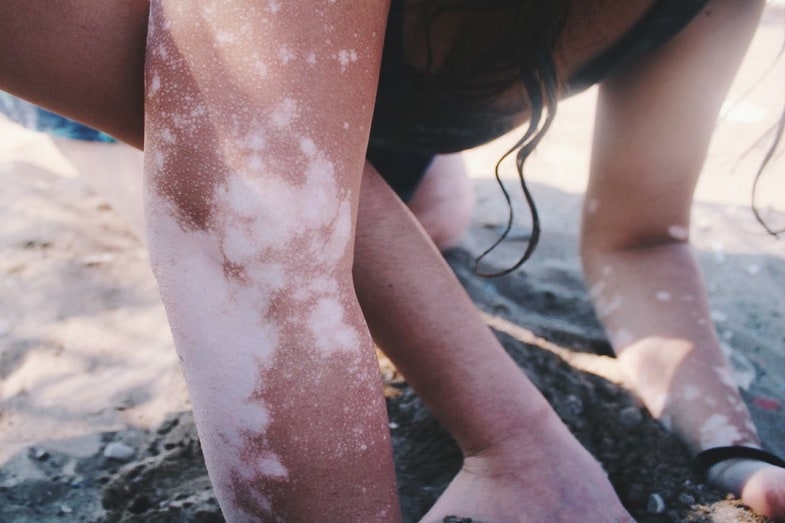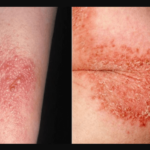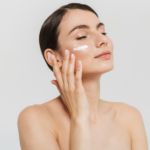Michael Jackson’s white skin made him more memorable in the eyes of his fans and critics. It was rumored that he had a skin disease called vitiligo. Could it be true, and what exactly is vitiligo?
Vitiligo is a chronic skin condition that causes patches of skin to lose their color. It appears that Michael had this skin condition because his dusky skin color turned to white over time.
The levels of melanin in his skin probably decreased–making him considerably whiter than his natural black skin tone.
Read on to learn more about vitiligo and Michael Jackson’s skin.
Also, for excellent sunscreen protection, take a look at our top pick, the Obagi Shield Broad Spectrum Sunscreen:
Click here to see it on Amazon.
What Is Vitiligo?
Michael’s skin color was dusky, but it progressively turned white as time went on. Initially, he developed noticeable white skin patches on his face, which many observers believed was vitiligo.
This chronic skin condition is characterized by the loss of the natural skin color on certain parts of the body. Vitiligo is not contagious and cannot be transmitted from one person to another.
This skin condition could start at any age, but there are studies that show that it is likely to appear when a person reaches the age of 20.
Melanin is the skin pigment that is responsible for the color of our skin. We have cells in our bodies that produce melanin. They are called melanocytes. These cells protect us from the sun’s harmful UV rays. Since vitiligo is photosensitive, the affected skin areas are more susceptible to the harmful rays of the sun than the unaffected ones.
It is very difficult to predict how vitiligo spreads in a person and by how much or how long it will take. The skin condition could take weeks, months, or even years to spread.
It may remain stable for some time and then spread out fast later in life. In the majority of cases, the change in skin color tends to be permanent. Michael’s case is more noticeable because the original color of his skin is black.
Probable Causes of Vitiligo
The main cause of vitiligo remains unclear up to this day. However, there are a number of factors that may contribute to its development. They include:
- Heredity
- Skin damage due to cuts or severe sunburn
- Autoimmune disorders such as an overactive immune system that kills melanocytes
- Neural disorders
- Genetic oxidative stress
- Exposure to harmful chemicals
- Viral infections
- Stressful events
Types of Vitiligo
Vitiligo is classified according to its type. The two types of vitiligo are segmental and non-segmental vitiligo.
1. Segmental Vitiligo
This type of vitiligo can spread faster. However, it is more stable, constant, and not erratic as the non-segmental type. It is not as common since it only affects around 10 percent of those with vitiligo. This skin condition is also non-symmetrical.
Segmental vitiligo is seen in 30 percent of children diagnosed with vitiligo. The usual affected areas are the skin that is attached to the nerves coming from the dorsal roots of the spine. Topical treatments are effective in treating this type of vitiligo.
2. Non-segmental Vitiligo
The patches of skin affected by this type of vitiligo are symmetrical. If the patches are limited to just one area of the body, the growth rate of vitiligo will be slower.
Non-segmental vitiligo is exhibited by around 90 percent of people diagnosed with vitiligo, making it the most common type.
Most often, the patches will appear on both sides of the body, hinting at a certain degree of symmetry. The patches appear on areas of the skin that are often exposed to the sun, such as the hands, face, and neck.
Non-segmental vitiligo is further classified into five categories. They are:
- Universal – Depigmentation occurs all over the body but is quite rare.
- Generalized – There is no specific affected area. The sizes of the patches are also not very specific. This type is the most common.
- Focal – One or fewer patches occur in a discreet area of the body. This type is often observed in small children.
- Mucosal – The patches appear around the lips and mucous membranes.
- Acrofacial – The patches are usually seen on the toes and fingers.
Facts You Need to Know About Vitiligo

Here are some interesting facts that you need to know about vitiligo:
- Vitiligo is a non-contagious skin condition.
- Vitiligo is a life-long skin condition without a cure.
- It can be treated in different ways. Some of the options include depigmentation if the case is severe and exposure to UVA or UVB light.
- All types of people, ethnicity, gender, and age can be affected by vitiligo.
- The exact cause of this condition is not yet fully understood. However, it is believed that it can be triggered by a virus or an autoimmune disorder.
What Are the Symptoms of Vitiligo?
There is only one symptom of vitiligo, and it is the appearance of white patches or white spots on the skin. The first patch is usually found on the skin area that had the most exposure to the sun.
Vitiligo starts with just a small spot, which looks paler than the skin that surrounds it. As time goes on, this pale spot will increase its paleness until it becomes white.
The shape of the patch is irregular. There are also cases where the edges of the patch become inflamed. These inflamed patches will have a slightly reddish color, which at times will result in itchiness.
Generally, the white patches will not cause any discomfort to the patient. These patches will not cause any soreness, irritation, or dryness of the skin.
The effects of vitiligo are not the same for all those who have it. Some may only develop a few white patches that do not multiply. Others may develop bigger white patches, which eventually combine themselves and affect bigger areas of the skin.
What Are the Most Common Treatments for Vitiligo?
The following are some helpful remedies that can minimize the visible effects of vitiligo:
1. Sunscreen Use
The American Academy of Dermatology recommends the use of sunscreen to minimize the effects of sunlight exposure in the white patches of vitiligo patients. These patches will easily get sunburned without sunscreen protection.
The Obagi Sun Shield Tint Broad Spectrum SPF 50 Sunscreen can provide effective sunscreen protection. It is hypoallergenic, fragrance-free, and provides protection against UVA and UVB sun rays.
Click here to see it on Amazon.
2. Skin Camouflage
If it is only mild vitiligo, you can use makeup and other cosmetics to camouflage the white patches.
3. Depigmentation
If the white patches are already widespread, one of the treatment options is depigmentation. This process will reduce the skin color of the areas that are not affected so that they will match the color of the white patches.
Click here to see it on Amazon.
A product that can be used for this purpose is the Merry Clinic Viti-Nutrients for Skin Pigmentation and Vitiligo. This product contains essential vitamins, minerals, and amino acids that can provide nutritional support to people with vitiligo.
4. Application of Corticosteroids
Some scientific studies have shown that applying corticosteroids to the white patches of the skin can stop it from spreading. There are a number of topical corticosteroids that can effectively help this skin condition.
5. Phototherapy Using UVA and UVB Light
UVA phototherapy is administered in a healthcare facility, while UVB phototherapy can be performed at home. These types of treatments tend to be more effective if patients are instructed to take supplements that support phototherapy.
The Recouleur Vitiligo Vitamin and Mineral Supplement for White Spot and Skin Pigmentation Support can be used for this purpose. It is a multivitamin and mineral supplement that the patient has to take for at least 6 months.
Click here to see it on Amazon.
Are There Any Complications of Vitiligo?
Generally, vitiligo will not develop or cause any other disease. However, those who are affected by this skin condition are more prone to develop the following complications:
- Changes in their tear production and vision
- Loss of hearing
- Painful sunburn
- Probability of developing other autoimmune disorders, such as type 1 diabetes, Hashimoto’s thyroiditis, Addison’s disease, and other thyroid gland problems. Most people with vitiligo seldom develop these conditions. However, it is recommended that they undergo medical tests to rule out these medical conditions.
Is Vitiligo the Skin Condition of Michael Jackson?

It cannot be denied that when Michael Jackson was still alive, his dusky skin color had progressively grown lighter and whiter over time. It was even rumored back then that he was using bleaching treatments to make his skin whiter.
More flames were added to that rumor since Michael also seemed to have his facial features changed through plastic surgery. The changes were noticeable, especially to his nose and chin. Rumor-mongers believed that he wanted to look more white than black.
With the white patches on his skin spreading out while being one of the most famous celebrities at that time, you can just imagine how determined he became to cover up his skin condition.
He probably felt embarrassed about his condition, particularly when he was in public and could not avoid the glare of cameras.
Michael Jackson’s skin condition is vitiligo. Hundreds, even thousands of photos showed that his skin turned white, which was very different from his original dusky skin tone. This skin condition made him lose his skin pigmentation.
He had it in small spots at first, but eventually, they spread out all over his body. The cause of his vitiligo was mainly attributed to his genes, suggesting that it runs in his family, particularly on his father’s side.
Michael even admitted that he had vitiligo in an interview with Oprah Winfrey in 1993 when he was 24 years old. He confided to Oprah that he noticed the pale spots developing after he recorded the Thriller album.
This album was released in 1982, 10 years before the Oprah interview. Therefore, his vitiligo progressed for 10 years.
Furthermore, when his body was autopsied after his death, the autopsy report indicated that “patches of light and dark pigmented areas” were found on his skin. Vitiligo was also listed as one of the diagnoses in his medical history.
This finding rules out the rumor that Michael bleached his skin to make it white. Michael’s close family members also did not confirm this rumor.
How Did Michael Jackson’s Skin Become White?
The main reason why Michael Jackson’s skin turned white was heredity. It was from his father, Joe, that he got this skin condition. While he was a teenager, Michael already noticed that he had skin patches that turned white.
Skin bleaching through Michael’s use of OTC skin whitening products was even rumored and suggested by J. Randy Taraborrelli, a celebrity biographer.
In addition, John Landis, an American director, said that he himself saw the bleached chest of Michael. However, Michael denied this by saying that he puts layers of makeup so that his skin tone would even out. Even his close friends and family members would not confirm this bleaching rumor.
Did Michael’s Plastic Surgery Procedures Affect His Skin Condition?
All the plastic surgery that Michael Jackson underwent did not in any way affect the transformation of his skin tone from dusky to white. He underwent nose surgery, presumably because it was broken in an accident while he was performing a routine dance practice.
There are speculations that he didn’t just have rhinoplasty but other surgical procedures as well. These procedures could include a forehead lift and a lip and cheekbone surgery, among others.
Conclusion
Michael Jackson’s skin condition is called vitiligo. It is characterized by white patches on the skin, which can spread over time in certain areas of the body. He inherited this genetic predisposition from his father, Joe. Although it is genetically transferred, vitiligo is not contagious.
Related reading:
Why Is Donald Trump’s Skin So Orange? 4 Possible Reasons
Why Do Some People Have Very Clear Skin? 7 Factors





![Neutral Skin Tone Defined [and Best Colors for Neutral Skin] neutral skin tone](https://skincaregeeks.com/wp-content/uploads/2021/05/neutral-skin-tone-150x150.png)







